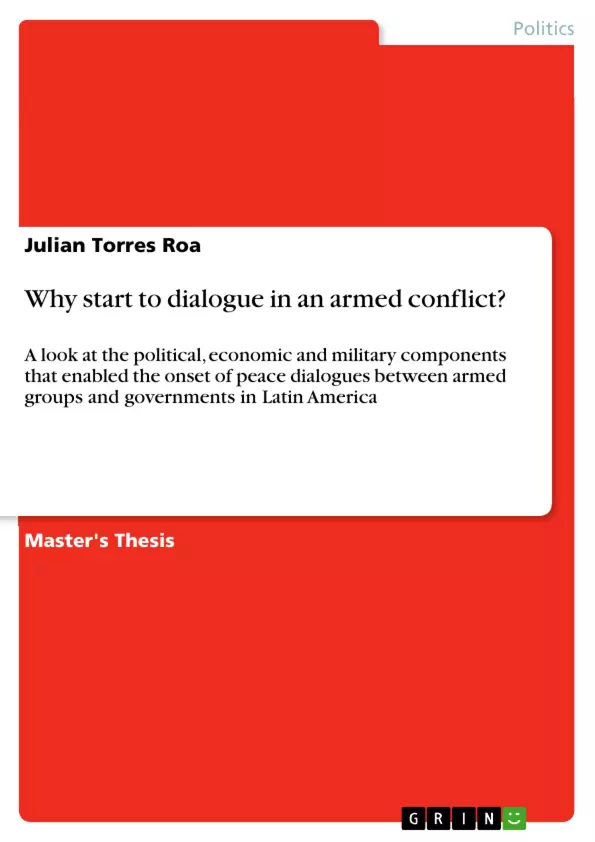The objective of this book is to compare different historical cases of internal armed conflicts in America, to identify the common conditions that previously recorded the cessation of armed actions and beginning of dialogues as a path for starting building a post-conflict scenario.
For this purpose, I will make a comparative historical analysis of three armed conflicts in Latin America who opted for the "dialogue" as a mechanism to end the confrontation with the state. The objective of this exercise is to identify the common elements, if any, that existed in the different selected cases when they decided to engage in conversations officially.
With the identification of these elements, I intend to demonstrate that there is a common causal explanation of the outcome of the cases, represented as a minimum necessary conditions in the historical development of different armed conflicts to achieve the implementation and development of dialogs between non-governmental armed groups and their governments.
The outcome of this work will be the identification of patterns of dynamics of internal armed conflicts based on the research findings, which will serve as a reference material for the study and possible early resolutions of armed conflicts in their social and political dimension stating the dialogue as an effective means to armed conflict resolution and there are enabling conditions that make it successful.
Inhaltsverzeichnis (Table of Contents)
- Introduction
- State of the art
- Conceptualization
- Cases Analysis
- Autodefensas unidas de Colombia - AUC
- Movimiento 19 de abril (M-19)
- Frente Farabundo Martí para la Liberación Nacional (FMLN)
- Analysis of cases
- Conclusions
- References
- Footnotes
Zielsetzung und Themenschwerpunkte (Objectives and Key Themes)
This article aims to compare historical cases of internal armed conflicts in Latin America, identifying common conditions leading to the cessation of armed actions and the initiation of peace dialogues. This research aims to understand the enabling factors contributing to the successful implementation of dialogues between armed groups and governments.
- The role of dialogue in resolving internal armed conflicts
- Identifying common conditions for the onset of peace dialogues
- Analyzing the dynamics of internal armed conflicts
- Examining the historical development of different armed conflicts
- Exploring the effectiveness of dialogue as a means of conflict resolution
Zusammenfassung der Kapitel (Chapter Summaries)
The introduction provides an overview of the global landscape of armed conflicts and the emergence of internal conflicts in Latin America. It highlights the rise of non-state armed groups and the challenges they pose to state authority. The "State of the art" section delves into existing literature on armed conflicts, focusing on post-conflict processes, peace-building, and the treatment of actors involved in the post-conflict scenario.
The "Conceptualization" chapter defines key terms like "guerrilla" and "paramilitary," providing a framework for understanding the different types of non-state armed actors involved in the case studies. The "Cases Analysis" section examines three specific cases: the Autodefensas Unidas de Colombia - AUC, the Movimiento 19 de abril (M-19), and the Frente Farabundo Martí para la Liberación Nacional (FMLN). Each case study explores the historical context, motivations, and strategies employed by these armed groups.
The "Analysis of cases" chapter draws comparisons between the selected cases, identifying common elements that facilitated the initiation of dialogues between the armed groups and their respective governments. This section aims to uncover patterns and potential causal explanations for the successful implementation of dialogue as a conflict resolution strategy.
Schlüsselwörter (Keywords)
The primary keywords and focus topics of this work include armed conflict, internal conflict, dialogue, government, and armed groups. The research centers on understanding the conditions and dynamics that enable dialogue as a means of resolving internal armed conflicts, particularly in Latin America.
- Citar trabajo
- Msc Political Science Julian Torres Roa (Autor), 2016, Why start to dialogue in an armed conflict?, Múnich, GRIN Verlag, https://www.grin.com/document/344519



